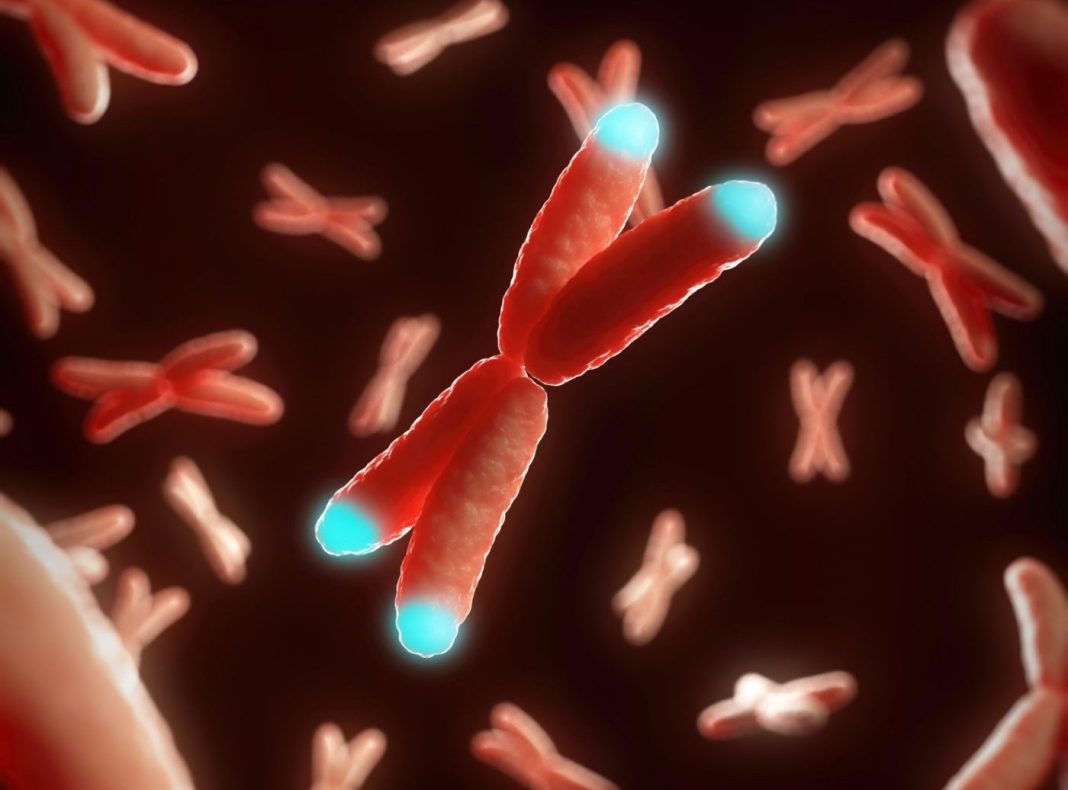University of North Carolina (UNC) researchers Taghreed Al-Turki, PhD, and Jack Griffith, PhD, have made the discovery that the telomeres on the ends of chromosomes contain genetic information that codes for two small proteins, one of which they found to be elevated in some human cancer cells, as well as in cells from patients suffering from telomere-related defects. The finding suggests that telomeres, which were once thought incapable of encoding proteins due to their simple repetitions of DNA, may have a key biological function that’s potentially relevant to our understanding of cancer and aging.
“Based on our research, we think simple blood tests for these proteins could provide a valuable screen for certain cancers and other human diseases,” said Griffith, the Kenan distinguished professor of microbiology and immunology and member of the UNC Lineberger Comprehensive Cancer Center. “These tests also could provide a measure of ‘telomere health,’ because we know telomeres shorten with age.”
Al-Turki and Griffith reported on their findings in PNAS, in a paper titled “Mammalian telomeric RNA (TERRA) can be translated to produce valine–arginine and glycine–leucine dipeptide repeat proteins,” in which they say their observations “suggest that telomeres, in particular in cells undergoing telomere dysfunction, may express two dipeptide repeat proteins with potentially strong biological properties.”
About 80 years ago, scientists first identified the elements at the ends of chromosomes that we now know as telomeres. In mammals and many other organisms, these telomeres contain a unique DNA sequence consisting of multiple repeats of TTAGGG bases— (TTAGGG)n repeats—that somehow inhibit chromosomes from sticking to each other. When cells divide, telomeres shorten, eventually becoming so short that the cell can no longer divide properly, leading to cell death.
Two decades ago, the Griffith laboratory showed that the end of a telomere’s DNA loops back on itself to form a tiny circle, thus hiding the end and blocking chromosome-to-chromosome fusions. It had also previously been shown that eurkaryotic telomeres are transcribed and produce a G-rich RNA known as TERRA. But established dogma in the field had held that because of their monotonous repetitive sequence, telomeres could not encode for proteins, let alone proteins with a potent biological function. As Griffith and Al-Turki noted in their newly released work, “It has been assumed that this RNA is purely structural and does not encode proteins.”
Interestingly, in 2011 a group in Florida working on an inherited form of ALS reported that the culprit was an RNA molecule containing a six-base repeat which by a novel mechanism could generate a series of toxic proteins consisting of two amino acids repeating one after the other. More generally, the UNC researchers explained, “Recent discoveries in several human nucleotide expansion diseases revealed that RNA transcripts containing long runs of 3 or 6 nt repeats which can form strong secondary structures can be translated in multiple frames to generate homopeptide or dipeptide repeat proteins, and multiple studies have shown them to be toxic in cells.”
In their latest work, Al-Turki and Griffith noted a striking similarity of the ALS-related RNA to the RNA generated from human telomeres, and they hypothesized that the same novel mechanism might be in play. “…the repeat-associated non-ATG translation mechanism (RAN) elucidated in several human diseases could, if utilized by mammalian TERRA, generate two dipeptide repeat proteins, repeating valine–arginine and repeating glycine–leucine,” they wrote.
For their reported study, the scientists carried out experiments to show that this telomeric DNA can instruct the cell to produce the two dipeptide repeat proteins, valine-arginine (VR)n, and glycine-leucine (GL)n, which acted as signaling proteins. Signaling proteins trigger a chain reaction of other proteins inside cells that then lead to a biological function that is important for health or disease.
Al-Turki and Griffith then chemically synthesized VR and GL, raised polyclonal antibodies to repeating VR dipepeptide protein, and examined the properties of the two proteins using techniques including electron and confocal microscopy, along with state-of-the-art biological methods. Their results revealed that the VR protein is present in elevated amounts in some human cancer cells, as well as in cells from patients suffering from disorders that result from defective telomeres. The results, the authors wrote, “suggest that these repeating dipeptide proteins are generated in greater amounts when cells undergo a telomere crisis. Their abundance could alter nucleic acid metabolism and general protein synthesis and trigger cellular inflammation responses.”

Al-Turki, a postdoc researcher in the Griffith lab, said, “We think it’s possible that as we age, the amount of VR and GL in our blood will steadily rise, potentially providing a new biomarker for biological age as contrasted to chronological age. We think inflammation may also trigger the production of these proteins.”
Griffith further noted, “When you go against current thinking, you are usually wrong because you are bucking many people who’ve worked so diligently in their fields. But occasionally scientists have failed to put observations from two very distant fields together and that’s what we did. Discovering that telomeres encode two novel signaling proteins will change our understanding of cancer, aging, and how cells communicate with other cells. Many questions remain to be answered, but our biggest priority now is developing a simple blood test for these proteins. This could inform us of our biological age and also provide warnings of issues, such as cancer or inflammation.”
Further research will be needed, however, the authors suggested. “Until more is known about these dipeptide repeat proteins, it would be a mistake to assume their only biological activity is related to toxicity. Future studies of the synthesis, degradation, and levels of VR and GL dipeptide proteins during the cell cycle and general analysis of their toxicity will be of great value in providing clues into their function in the cell.”


